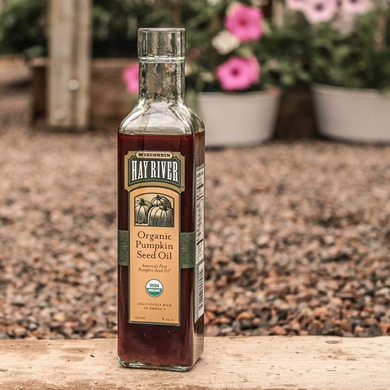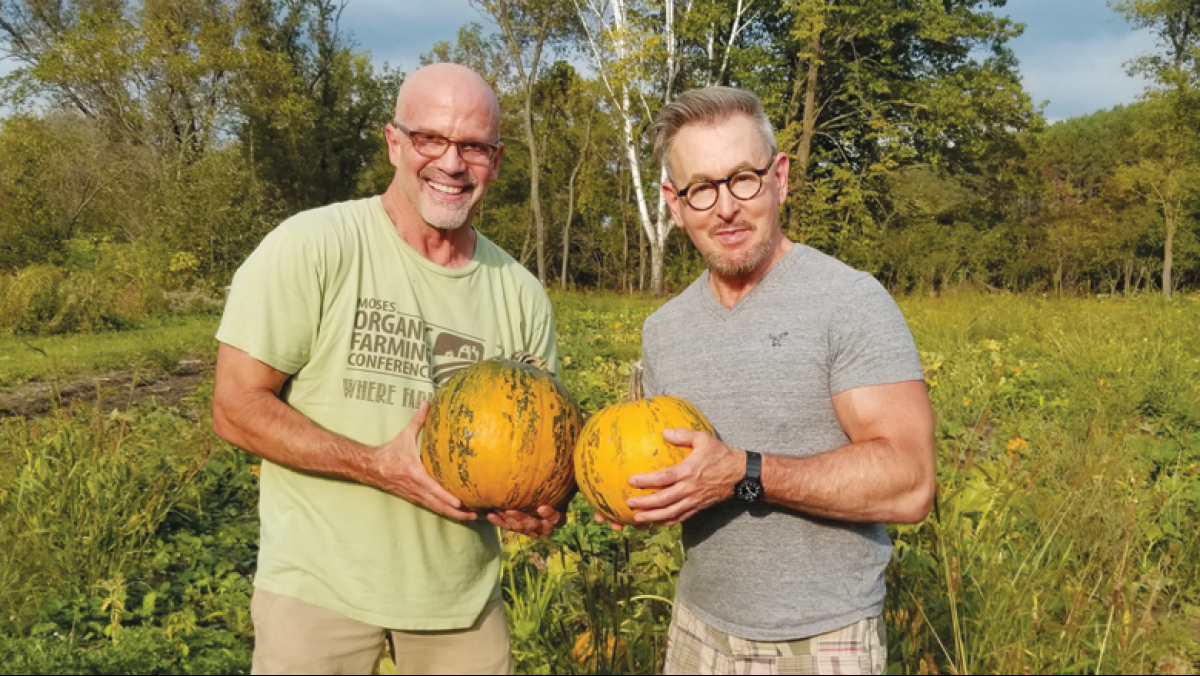When most of us think of pumpkins, we envision the Halloween variety, plump and full of white seeds that, when roasted, transform into a delicious snack. At Hay River Farm, just about an hour north of Eau Claire in rural Prairie Farm, Ken Seguine and Jay Gilbertson grow a variety of pumpkins containing “naked” seeds without the protective white coating known as the testa. While these little green seeds are also good for snacking, they are perfect for making pumpkin seed oil, a delicious and versatile cold-pressed oil that is one of many kinds of seed oil being produced throughout the state today.
First cultivated and harvested by Native Americans long ago, pumpkins were brought to Europe by Christopher Columbus and quickly adopted as an easy-to-grow-and-store staple food. Extremely popular in Austria, pumpkins were declared “medicinal” because of the perceived health benefits from the oil-rich seeds. The Austrians were the first to create the standards and processes for making pumpkin seed oil and are still the largest consumers and producers of it to this day.
Indeed it was an Austrian-American, Aveda founder Horst Rechelbacher, who introduced Seguine to pumpkin seed oil when Seguine was working for the plant-based cosmetics company in the 1990s. The two were attending an international natural product trade show when they stopped by an Austrian booth that had sample bottles of pumpkin seed oil. “I had never tasted anything like it,” recalls Seguine.
 While Seguine and Gilbertson searched Northwestern Wisconsin for a farm that might be suitable for growing pumpkins, the two were also considering a few other value-added crops for cultivation, including peonies. It wasn’t until they attended a Midwest Organic and Sustainable Education Service conference in Eau Claire that Seguine and Gilbertson decided to go all in on pumpkin seed oil. What convinced them was a presentation by Mark Mueller of Botanic Innovations, encouraging farmers to take advantage of high-value seed oil crops such as broccoli, cranberries, and pumpkins. Mueller pointed to a spectrum of cold-pressed oils that he was making with the help of local farmers at his facility in Spooner, noting how the cold-press process helped retain the natural antioxidants and nutrients found in the seeds.
While Seguine and Gilbertson searched Northwestern Wisconsin for a farm that might be suitable for growing pumpkins, the two were also considering a few other value-added crops for cultivation, including peonies. It wasn’t until they attended a Midwest Organic and Sustainable Education Service conference in Eau Claire that Seguine and Gilbertson decided to go all in on pumpkin seed oil. What convinced them was a presentation by Mark Mueller of Botanic Innovations, encouraging farmers to take advantage of high-value seed oil crops such as broccoli, cranberries, and pumpkins. Mueller pointed to a spectrum of cold-pressed oils that he was making with the help of local farmers at his facility in Spooner, noting how the cold-press process helped retain the natural antioxidants and nutrients found in the seeds.
Shortly after establishing Hay River Farm in 2001, Seguine and Gilbertson narrowed their focus to a very specific type of naked-seed pumpkin known for producing exceptional oil. Their trial patch performed so well that they tried successively larger and larger patches until their first official crop was harvested in 2006. Seguine says it takes about a dozen pumpkins to produce enough seeds for one 8.45 ounce bottle of oil, which costs around $24.
Over the last thirteen years, Seguine and Gilbertson have learned a few things about making superlative pumpkin seed oil, and they have even become organic certified. During this time they also purchased some very specific equipment for harvest: a Turkish-made machine that speeds up their timeline for harvesting and cleaning the seeds, and modified corn-drying equipment that hastens the drying process. After processing, the seeds are taken to Botanic Innovations in Spooner for cold pressing. Bottling and labeling are done back at Hay River Farm.
The resulting product is as beautiful as it is nutritional, a dark red oil that is rich in antioxidants, omega-3s, and lutein (a carotenoid similar to vitamin A). The oil is best used for finishing: giving that extra lift to soups, as a substitute for butter on popcorn or bread, drizzled on ice cream, or as an ingredient in homemade salad dressings (pumpkin seed oil is not ideal for cooking).
For Seguine and Gilbertson, farming pumpkins has become a passion project. “Neither of us are from a farming background, so we started out with nausea and despair,” says Seguine. “But, very, very slowly it became almost fun. And now it’s lots of fun.”
The two hope to harvest 2,000 pounds of seed in 2020. They are also experimenting with some new Austrian pumpkin varieties developed to be more disease resistant and climate tolerant. While the partners now employ a few people on a seasonal basis, they hope to expand their business to up to eight full-time employees, and to hire other local farmers to help plant and harvest hundreds of acres of their orange-and-green-striped pumpkins.
• • • • •
Mark Mueller isn’t a farmer, but he believes there is huge potential for growth in plant-based oils. Mueller founded Botanic Innovations in 1999 to turn nutrient-rich fruit and plant seeds into dietary supplements and botanical oils. Botanic Innovations developed and trademarked the NatureFRESH Cold-Press method, which uses tremendous mechanical pressure to extract seed oil that retains the nutrients found in the cotyledon structure of the seed—the place that stores the polyunsaturated fats and omega-3 fatty acids the embryonic plants draw on during early stages of germination.
 This is the good stuff that Mueller says commercial-brand vegetable and canola oil makers often strip out by using a solvent called hexane to extract the seed oil cheaply and efficiently before bleaching it for uniformity of color. “Unfortunately, when they bleach the oils, they are losing some of the good antioxidants, the carotenoids, the sterols, which have the ability to combat cholesterol,” says Mueller. Ironically, the application of hexane and heat to refine the oil removes vitamin E, which has preservative qualities. This means that commercial producers also have to add preservatives to provide their oils with a longer shelf life.
This is the good stuff that Mueller says commercial-brand vegetable and canola oil makers often strip out by using a solvent called hexane to extract the seed oil cheaply and efficiently before bleaching it for uniformity of color. “Unfortunately, when they bleach the oils, they are losing some of the good antioxidants, the carotenoids, the sterols, which have the ability to combat cholesterol,” says Mueller. Ironically, the application of hexane and heat to refine the oil removes vitamin E, which has preservative qualities. This means that commercial producers also have to add preservatives to provide their oils with a longer shelf life.
As an FDA-registered dietary supplement manufacturer, Botanic Innovations follows strict guidelines in processing its products. Mueller and his production team ensure that seeds are free of any type of foreign material before they’re pressed and test every single batch of oil for pesticides and metals. In addition to processing seeds for small-batch seed oil producers, Botanic Innovations has its own line of botanical supplements and skin care products, including the recently released SO Plus, a ready-to-eat nutrition mix containing fruit seed powders and oils.
Mueller says there is a lot of opportunity in the state for growing good seed oil plants: watermelon, broccoli, and cranberries are just a few. Even though he recently relocated Botanic Innovations to a larger facility in Spooner, where the business was originally headquartered, he still sees room for more growth. “Consumers today are looking for more healthy products to put on their skin as well as to ingest,” says Mueller. “We think cold pressing has the right future.”
• • • • •
Josh Engel and his brother Noah have been growing potatoes since they were kids. The two are co-founders of Driftless Organics, a hundred-acre farm nestled in the ridges and valleys of the Driftless Area of Southwest Wisconsin. Well known for its popular community-supported agriculture program and stalls at the Dane County Farmers’ Market, Driftless Organics also supplies several Madison-area restaurants with organic broccoli, cauliflower, strawberries, squash, lettuce, carrots, zucchini, and other vegetables.
Always on the lookout for ways to diversify the farm’s revenue sources, Josh Engel decided to try growing seed oil sunflowers after reading an article that referenced both Hay River Farm and Botanic Innovations. Engel planted his first crop of sunflowers in 2007, but, due to heavy rains that year, the fields flooded and the crop was lost. After another failed crop in 2008, the farm had a successful harvest in 2009.
Engel admits to some trial and error in figuring out the best way to grow sunflowers. Planting happens some time in June. The sunflowers take one or two months to come to full bloom, then are left in the field for up to two more months to begin the drying process. Because the hilly Driftless Area has a moisture-heavy climate, the sunflowers grow a lot taller than they would in, say, the flatlands of Central Wisconsin.
While high winds and hungry deer are two threats to a healthy harvest, Engel says that the biggest factor to consider in growing sunflowers is birds, which can consume an entire crop of seeds in just a few days. To discourage the birds, Engel thins his plantings so the sunflowers don’t grow too tall in their competition for sunlight. When sunflowers are shorter, more of their energy goes into growing a larger flower. The bigger the flower, the more likely it is to bend down as the seeds mature and dry, thereby keeping most birds (that can’t fly upside down) and rain away from the seeds.
The seeds, a black oil sunflower variety that you would find in commercial birdseed, are harvested with a modified combine, then stored and further dried and conditioned with air, a process that takes anywhere from six to eighteen months. According to Engel, the drier they get, the better they press. Once the seeds are fully dried and conditioned, they are run through a cleaning machine and then taken to Botanic Innovations to be pressed, filtered, and bottled into half pints, pints, half gallons, and gallons.
Today the farm is producing between 1,000 and 1,500 gallons of sunflower oil from around 15 acres of sunflowers. The oil, which has characteristics very similar to a light olive oil, is low in saturated fats and high in oleic acid and vitamin E. Like pumpkin seed oil, sunflower oil can be used as a finishing oil. Because it has a smoking point of 225 degrees, it can be used in baking and sautéing but not frying. According to Engel, the base of most commercial vegetable oils you find in the store is actually refined sunflower oil. But Driftless Organics’ is unrefined, and this contributes to its rich, nutty flavor and helps retain beneficial compounds that might otherwise be lost in the refining process.
While Driftless Organics sunflower oil can be purchased at its farmers’ market stalls and Willy Street Coop in Madison, Engel says that it is still very much a niche product. He notes that visitors from Eastern Europe and Russia, where sunflower oil is common, pay more attention to his oil than the regular farmers’ market crowd. However, he hopes the market for his Driftless-made product will grow as awareness about the health benefits of cold-pressed oils grows.
“Someday, we’d like to be known as the olive oil of the Midwest,” says Engel.
• • • • •
On the eastern side of the state in Marshall, just between Madison and Milwaukee, you’ll find Jamie Derr raising and producing his own small-batch version of one of the more mainstream cooking oils. Derr, who launched his Farm Fresh canola oil brand a little over a year ago, handles everything from seed to sale in his business.
A fourth generation farmer with a passion for addressing climate change on the local level, Derr composts everything he can on his farm and is working toward a zero waste system. “I’m trying to get farmers to realize there are some real practical ways to do something about climate change,” says Derr.
In fact, it was Derr’s interest in biodiesel fuel, sparked by conversations with Great Dane Pub brewmaster Rob LoBreglio, that led him to canola oil in the first place. In 2005, Derr received a grant to build a biodiesel production unit in a semi trailer on his farm. He used his slow times in winter to work on this new project, collaborating with LoBreglio to create biodiesel fuel by recycling used cooking oil from Great Dane and Eddie’s Alehouse in Sun Prairie. A more environmentally friendly alternative to petroleum-based fuels, biodiesel fuel can be used to power all kinds of vehicles and farm implements that run on traditional diesel fuel. By the second year, Derr was biodiesel certified, and he still makes biodiesel fuel to power his delivery wagon and farm equipment.
In the process of teaching him how to make biodiesel fuel, LoBreglio also showed Derr how to create cold-pressed canola oil for use in salad dressings, deep fryers, and the like. The flavor and texture of Farm Fresh canola oil mimics that of melted butter, and the product can be used in high-heat applications like roasting and grilling. Derr quickly realized that producing a food product from his crops, rather than fuel, generated more revenue. So he decided to invest more time in his Farm Fresh canola oil business.
Canola oil comes from rapeseed, cold-hardy plants that can be sowed right away in April and grow about waist high by midsummer. A member of the Brassica family (which includes mustard, cabbage, and broccoli), rapeseed plants have bright yellow flowers that form pods in which the seeds grow. By August, the plants are ready to be swathed, or cut, even though the seed is only about half ripe. Derr then rakes the swathed plants into windrows, allowing them to dry a bit in the field before collecting the fragile seedpods with a special head on a combine that works like a conveyor belt. At 35 pounds per acre, the yield sounds low, says Derr, but the earning potential is big—easily more than corn—when you utilize all parts of the rapeseed harvest, creating oil plus livestock feed from the leftover meal.
A bushel basket of seed produces well over a gallon of oil. Production is simple: Derr uses small, German-made screw presses to extract the oil, then filters and bottles it. “People don’t understand that [most cooking oil] is a super processed food—it’s the Twinkies of oil.”
Derr, like many producers, is hopeful about the future of cold-pressed seed oils in Wisconsin. “This is Wisconsin’s olive oil. Whether it’s canola, sunflower, pumpkin seed, we’re cold pressing,” he says, adding, “Life’s too short for cheap beer and cheap cooking oil. I hope someday there’s that awakening.”




